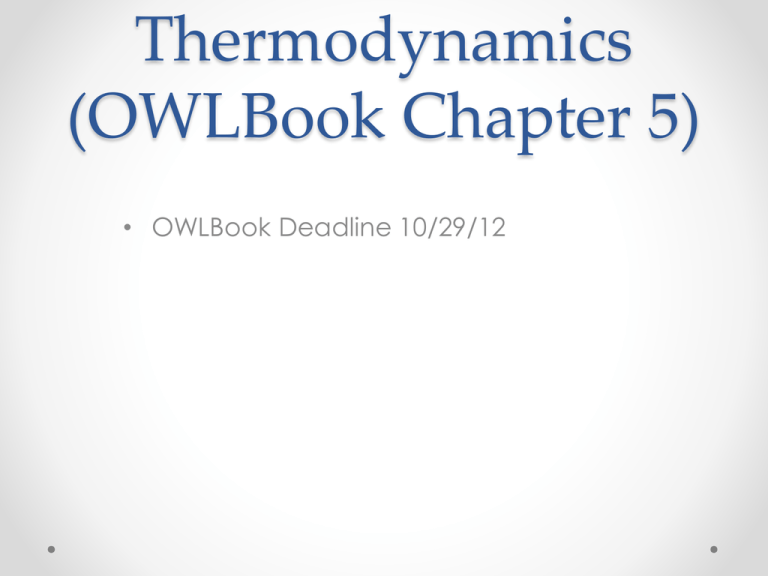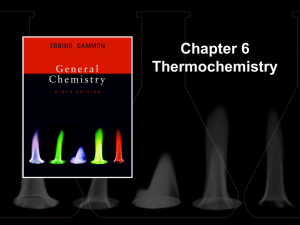
Thermodynamics
(OWLBook Chapter 5)
• OWLBook Deadline 10/29/12
5.1 Energy and Work
Kinetic Energy, EK
The energy associated with an object by virtue of its motion.
1
EK mv 2
2
m = mass (kg)
v = velocity (m/s)
Potential Energy, EP
The energy an object has by virtue of its position in a field of force, such as
gravitaitonal, electric or magnetic field.
Gravitational potential energy is given by the equation
E P mgh
m = mass (kg)
g = gravitational constant (9.80 m/s2)
h = height (m)
Units/Conversions/Conservat
ion
kg m 2
J
s2
1 cal 4.184 J (exact)
Law of Conservation of Energy
Energy may be converted from one form to
another, but the total quantity of energy
remains constant.
• Thermodynamic System
• The substance under study in
which a change occurs is
called the thermodynamic
system (or just system).
• Thermodynamic Surroundings
• Everything else in the vicinity
is called the thermodynamic
surroundings (or just the
surroundings).
Signs and Conventions
Enthalpy (H)
• Enthalpy, H
• An extensive property of a substance that can be used
to obtain the heat absorbed or evolved in a chemical
reaction.
• Extensive Property: A property that depends on the
amount of substance. Mass and volume are extensive
properties.
Endothermic or Exothermic
Let’s do quick the OWLBook Check 5.2.1
Applying Stoichiometry to Heats of Reaction
Enthalpy Change and
Stoichiometry
• Sulfur, S8, burns in air to produce sulfur
dioxide. The reaction evolves 9.31 kJ
of heat per gram of sulfur (S8) at
constant pressure.
o Write the balanced chemical equation
o Write a thermochemical equation for this reaction,
expressing the change in enthalpy in kJ/mole of S8.
o If 48 grams of sulfur is burned in an excess of oxygen,
how much heat is produced?
A bomb calorimeter
Energy and State Changes
Let’s do this and create the phase change diagram for this problem.
Enthalpy
and
Reactions
Constant
Pressure!
Remember Energy is
Conserved
• 0 = qsystem + qsurroundings
• qsurroundings = (mass of calorimeter
contents) x (specific heat) x ΔT
• ΔH = qsystem = -qsurroundings
• Specific Heat Capacity, s (or specific heat)
oThe quantity of heat needed to
raise the temperature of one
gram of substance by one
degree Celsius (or one Kelvin) at
constant pressure.
A piece of zinc weighing 35.8 g was
heated from 20.00°C to 28.00°C. How
much heat was required? The specific
heat of zinc is 0.388 J/(g°C).
Let’s do OWLBook Tutorial 5.4.3.
Hess’s Law
• Enthalpy is a State Function. It is the starting point
and ending point that matter, NOT how you get
there.
Hess’s Law
• If you flip a reaction, the sign on ΔH changes.
• If you multiply a reaction by a number, ΔH gets
multiplied by that same number.
• You can use any number or combination of
reactions to get from point “A”-reactants to point
“B” –products.
• Used when reactions are slow, hard to measure, or
even theoretical (never been done before).
• Suppose we want DH for the reaction
• 2C(graphite) + O2(g) 2CO(g)
• It is difficult to measure directly.
• However, two other reactions are known:
C(graphite) + O2(g) CO2(g); ΔH = -393.5 kJ
• 2CO2(g) 2CO(g) + O2(g); ΔH = – 566.0 kJ
In order for these to add to give the reaction we want, we
must multiply the first reaction by 2. Note that we also
multiply ΔH by 2.
• Our Goal = 2C(graphite) + O2(g) 2CO(g)
• 2C(graphite) + 2O2(g) 2CO2(g); DH = -787.0 kJ
• 2CO2(g) 2CO(g) + O2(g); DH = – 566.0 kJ
2 C(graphite) + O2(g) 2 CO(g); DH = –1353.0 kJ
Copyright © Cengage Learning. All rights reserved.
6 | 27
• What is the enthalpy of reaction, DH, for the reaction
of calcium metal with water?
Ca(s) + 2H2O(l) Ca2+(aq) + 2OH-(aq) + H2(g)
This reaction occurs very slowly, so it is
impractical to measure DH directly. However,
the following facts are known:
H+(aq) + OH-(aq) H2O(l); DH = –55.9 kJ
Ca(s) + 2H+(aq)
Ca2+(aq) + H2(g); DH = –543.0 kJ
Copyright © Cengage Learning. All rights reserved.
6 | 29
Standard Enthalpy
• Standard Enthalpies of Formation
• The term standard state refers to the standard
thermodynamic conditions chosen for substances
when listing or comparing thermodynamic data:
o 1 atm pressure and the specified temperature (usually 25°C).
o These standard conditions are indicated with a degree sign
(°).
• When reactants in their standard states yield products
in their standard states, the enthalpy of reaction is
called the standard enthalpy of reaction, DH°. (DH° is
read “delta H zero.”)
The standard enthalpy of formation, DHf°, is the
enthalpy change for the formation of one mole of
the substance from its elements in their reference
forms and in their standard states. DHf° for an
element in its reference and standard state is zero.
For example, the standard enthalpy of formation
for liquid water is the enthalpy change for the
reaction
H2(g) + 1/2O2(g) H2O(l)
DHf° = –285.8 kJ
Other DHf° values are found in various reference
tables (not necessary to be memorized, except
for… DHf° for an element in its reference and
standard state
Remember, these are for formation of
these substances from their constituent
elements in reference states.
Using Standard Enthalpies of Formation….
We want DH° for the reaction:
CH3OH(l) CH3OH(g)
ΔH reaction
nΔH f
products
For liquid methanol :
nΔH f
reactants
ΔH f
For gaseous methanol :
kJ
238.7
mol
ΔH f
kJ
200.7
mol
kJ
kJ
ΔH v ap 1 mol 200.7
1 mol 238.7
mol
mol
DHvap= +38.0 kJ
• Methyl alcohol, CH3OH, is toxic because liver
enzymes oxidize it to formaldehyde, HCHO, which
can coagulate protein. Calculate DHo for the
following reaction:
2CH3OH(aq) + O2(g) 2HCHO(aq) + 2H2O(l)
Standard enthalpies of formation,ΔH fo :
CH3OH(aq): -245.9 kJ/mol
HCHO(aq):
-150.2 kJ/mol
H2O(l):
-285.8 kJ/mol
ΔH reaction
nΔH f
products
nΔH f
reactants








